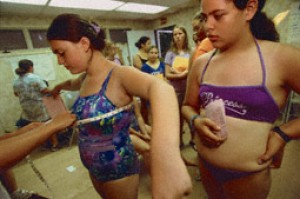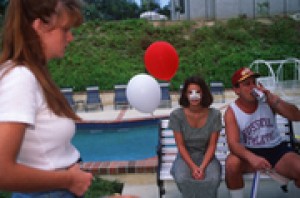This Exhibit Contains Graphic Content: Lauren Greenfield at the Getty
Although Los Angeles-based photographer and documentary filmmakerLauren Greenfield has built her reputation as a chronicler of mainstream American culture, a large percentage of her work in the new group exhibit, “Engaged Observers” revolves around the question, “How exactly do Jews figure into the beauty cult?”
In photographs dating from the 1960s to the present, Greenfield calls attention to the ways Jewish girls have navigated the perils of the beauty culture. These means skirt the scary and edge toward the harrowing. From surgery to starvation, from dressing up beyond their years to being dressed like dolls, Jewish girls, at least in Greenfield’s world, have not scored high marks in celebrating their diversity.
One particularly striking series documents a family’s experience of their young daughter’s nose job. In this series, the viewer is invited first into the operating room and then the home, where the bandaged and bruised teen recovers poolside. From the brutality of the nose breaking and reconstructing under the surgery room’s fluorescent lights to the idyll of the backyard cum swimming pool that is tainted by the girl’s trauma, the reaction of the father as portrayed is visceral; we can feel his loss of power.
Another series portrays a young girl, no more than ten or eleven, dressed in full make-up and a Chanel-style skirt suit. In one photo, the frighteningly thin child, cultivating the look of a young adult woman, stands fully dressed on a bathroom scale. Her parents are posed in the doorway, audience to a particular sort of freak show.

© Lauren Greenfield/INSTITUTE
Danielle, 13, gets measured as Michelle, 13, waits for the final weigh in on the last day of weight loss camp, Catskills, New York. From the series Girl Culture. Lauren Greenfield, negative, 2001; print, 2002
Greenfield’s photos work to evoke a range of reactions and questions; are the parents responsible for their children’s risky behavior? Is the culture responsible and the parents merely helpless observers, out of their ken?
Given that Greenfield is the author of Girl Culture her focus on young girls and their obsessions is perhaps not surprising. Yet, while our eyes are drawn to the girls in these images, the tension in the images is derived from the observers in the scene, the parents and by extension the society that creates the beauty culture in which these girls must live.
In some cases, Greenfield underscores this effect by eliding the girls completely, as in one photo of a young boy at his Bar Mitzvah. The boy is perfectly healthy. Instead, our gaze goes to his bone-thin mother, photographed from the back in a black, backless dress. Her skeletal presence is what presides and what counts here, not the wishes and desires of her children.
Not far away is the suggestion that we, the onlookers, are the most engaged observers of all. It is our gaze, at the bat mitzvahs and weddings that impels the actors in these scenes. Engaged Observers holds up a mirror to contemporary notions of Jewish beauty—and in a paradox worthy of the art this is, the image we see of ourselves is one we first must embrace, if we want anything about our culture to change.
![[the current issue of ZEEK]](../../image/2/100/0/5/uploads/leftistethicistgraphic-52842c6a.png)
- 5000 Pages of Zeek
- Founded in 2001, Zeek was the first Jewish online magazine, and we have over 5000 pages online to prove it, all available free of charge. Read more in the Archive.
More articles by
Joan Gelfand
More articles in
Arts and Culture
- Euphoria, Curiosity, Exile & the Ongoing Journey of a Hasidic Rebel: A Q & A with Shulem Deen
- Poet Q, Poet A: Jews Are Funny! Six Poets on Jewish Humor, Poetry & Activism and Survival
- Tackling Hate Speech With Textiles: Robin Atlas in New York for Tu B’Shvat
- Fiction: Angels Out of America
- When Is an Acceptance Speech Really a Speech About Acceptance?


